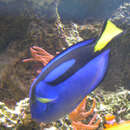Diagnostic Description
provided by Fishbase
Description: Characterized further by having contrasting pattern of bright blue and black; black-edged yellow caudal fin; single retractable caudal spine on each side of caudal peduncle; greatest depth of body 2.1-2.4 in SL (Ref. 90102).
- Recorder
- Cristina V. Garilao
Diseases and Parasites
provided by Fishbase
Hole-in-the-Head Disease. Parasitic infestations (protozoa, worms, etc.)
Morphology
provided by Fishbase
Dorsal spines (total): 9; Dorsal soft rays (total): 19 - 20; Analspines: 3; Analsoft rays: 18 - 19
- Recorder
- Cristina V. Garilao
Trophic Strategy
provided by Fishbase
It is generally found in clear water of outer reefs or channels where there are strong currents. Juveniles tend to hide among the branches of live coral (Ref. 54301). Occurs in clear, current-swept terraces of seaward reefs. Observed in loose aggregations 1 or 2 meters above the bottom; juveniles and subadults typical in groups near isolated Pocillopora eydouxi coral heads and when alarmed hide themselves tightly among the branches. Feeds on zooplankton (Ref. 9710, 48637). Diurnal species (Ref. 113699:32; 120956:331), courtship and spawning occurs from mid-afternoon to dusk (Ref. 38697).
Biology
provided by Fishbase
Occur in clear, current-swept terraces of seaward reefs. Observed in loose aggregations 1 or 2 meters above the bottom; juveniles and subadults typical in groups near isolated Pocillopora eydouxi coral heads and when alarmed hide themselves tightly among the branches (Ref. 9710). Benthopelagic (Ref. 58302). Feed on zooplankton and occasionally on algae (Ref. 9710, 48637, 27115, 83665). Relatively uncommon and highly localized (Ref. 1602, 9710). Very popular and hardy aquarium fish. Anterolateral glandular groove with venom gland (Ref. 57406).
- Recorder
- Estelita Emily Capuli
Importance
provided by Fishbase
aquarium: commercial
- Recorder
- Estelita Emily Capuli

